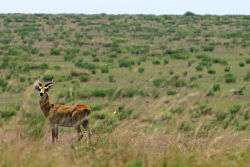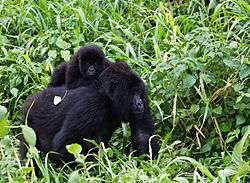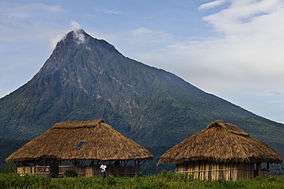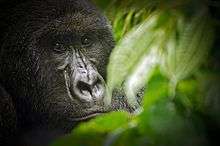Virunga National Park
| Virunga National Park | |
|---|---|
|
IUCN category II (national park) | |
|
Bukima Camp in the foothills of Mikeno Mountain, home of the Congolese mountain gorillas | |
 | |
| Location | Democratic Republic of the Congo |
| Nearest city | Goma |
| Coordinates | 0°55′0″S 29°10′0″E / 0.91667°S 29.16667°ECoordinates: 0°55′0″S 29°10′0″E / 0.91667°S 29.16667°E |
| Area | 7,800 km2 (1,900,000 acres) |
| Established | 1925 |
| Governing body | Institut Congolais pour la Conservation de la Nature |
| Type | Natural |
| Criteria | vii, viii, x |
| Designated | 1979 (3rd session) |
| Reference no. | 63 |
| State Party |
|
| Region | Africa |
| Endangered | 1994–present |
The Virunga National Park (French: Parc National des Virunga), formerly named Albert National Park, is a 7,800-square-kilometre (3,000 sq mi) National Park that stretches from the Virunga Mountains in the South, to the Rwenzori Mountains in the North, in the eastern Democratic Republic of the Congo, bordering Volcanoes National Park in Rwanda and Rwenzori Mountains National Park and Queen Elizabeth National Park in Uganda.
The park was established in 1925 as Africa's first national park and is a UNESCO-designated World Heritage Site since 1979. In recent years, poaching and the Congo Civil War have seriously damaged its wildlife population. The park is managed by the Congolese National Park Authorities, the Institut Congolais pour la Conservation de la Nature (ICCN) and its partner the Virunga Foundation, formerly known as the Africa Conservation Fund (UK). The current park director since 2008 is the Belgian Prince Emmanuel de Merode.
History
The park was created in 1925 by King Albert I of Belgium as the first national park on the continent of Africa. It was founded primarily to protect the mountain gorillas[1] living in the forests of the Virunga Mountains controlled by the Belgian Congo, but later expanded north to include the Rwindi Plains, Lake Edward and the Rwenzori Mountains in the far north.




In the first 35 years, the boundary of the park took shape, poaching was kept to a minimum, and sustainable tourism thrived due to the work of a large body of hand-picked Congolese rangers and dedicated wardens. Land remuneration and the use of park resources such as fishing and hunting by the local population became an ongoing problem and attempts were made to solve these issues.
When the Belgians granted Congo independence in 1960 the new state deteriorated rapidly, and so did the park. It was only in 1969 when President Mobutu began to take a personal interest in conservation, that the park was revived. In the process of Mobutu's Africanization campaign, it was renamed Virunga National Park, and the first Congolese Wildlife Authority was established.
Virunga fared well for the better part of the 1970s. Foreign investment helped to improve the park's infrastructure and training facilities, and the park became a popular destination for tourists, receiving on average 6500 visitors a year. In 1979 UNESCO designated the park as a World Heritage Site.[2]
In the mid-1980s the Mobutu regime began to lose its hold on power and the country began a long slide into chaos. The park suffered terribly. Poaching depleted Virunga's large mammal populations, infrastructure was destroyed, and many rangers were killed. The Congolese Wildlife Authority slowly lost control of Virunga and UNESCO changed the World Heritage Site status to "endangered."[2]
In 2013 the World Wildlife Fund raised concerns about plans by the UK based Soco International to carry out exploration for oil in the park.[3] Currently more than 80% of Virunga National Park has been allocated as oil concessions.[4] Soco International's own environmental impact assessment reports admit that oil exploration is likely to cause pollution, irreparably damage habitats and bring poaching to the park. The World Wildlife Fund have launched a campaign to petition[5] Soco to refrain exploring the world heritage area for oil, and thereby avoid these outcomes. As of August 30, 2014, SOCO demobilized its operations in the DRC.
World Wildlife Fund executives now acknowledge that the battle over Virunga is hardly over. SOCO has yet to relinquish its operating permits or commit to an unconditional withdrawal.[6]
Geography
Virunga National Park is unrivaled in its diversity of landscapes and ecosystems.

 The Lava Lake of the Nyiragongo Volcano, the largest in the world
The Lava Lake of the Nyiragongo Volcano, the largest in the world Virunga NP mountain gorillas
Virunga NP mountain gorillas Bukima Camp is situated in the foothills of the Mikeno Mountain, the home of the Congolese mountain gorillas
Bukima Camp is situated in the foothills of the Mikeno Mountain, the home of the Congolese mountain gorillas Rwenzori Mountains
Rwenzori Mountains Silverback of the Rugendo family at Bukima patrol Post
Silverback of the Rugendo family at Bukima patrol Post The cabanes are situated at the edge of the crater in sight of the lava lake, the sight of which has an astounding effect on visitors
The cabanes are situated at the edge of the crater in sight of the lava lake, the sight of which has an astounding effect on visitors Two Congo lion males resting in an open area within the National Park near Rwindi
Two Congo lion males resting in an open area within the National Park near Rwindi
|
|
|
Biodiversity

The park is known for its exceptional (bio)diversity, containing more bird, mammal and reptile species than any protected area on the African continent. Although mountain gorillas are now extremely rare and listed as one of the most critically endangered species, successful conservation work has helped to secure the remaining populations. Their populations actually increased during the years of political upheaval in the region (1994–2004), and have continued to do so even throughout the difficult period of 2007-2008. The 2010 mountain gorilla census has indicated that the conservation efforts of Virunga have been very successful regarding the gorilla population. Both savanna and forest elephants as well as chimpanzees and low land gorillas can still be found in Virunga, along with okapi, giraffes, buffaloes and many endemic birds. The neighboring Mount Hoyo area was managed with the park and is home to a population of Bambuti pygmy people, caves and waterfalls.
Human conflict
Since the civil wars, the park has suffered somewhat. Land invasions and intense poaching have challenged the park authorities to the limit, but most rangers have remained active. Since 1994, about 140 rangers have been killed in the line of duty protecting the park from illegal poaching and land acquisition.[7] Amongst other military activity, the Democratic Forces for the Liberation of Rwanda (FDLR) used the park as a safe location when they have come under sustained attack, such as Laurent Nkunda's offensives against them in April–May 2007.[8] The park was occupied by Nkunda's forces on 26 October 2008, during the Battle of Goma.
Current situation
However over the last three years the park has seen remarkable regeneration, with heavy investment in tourism development, social infrastructure as well as safety. Currently over 3000 tourists a year visit the southern sector of Virunga National Park to admire the gorillas as well as the lava lake of the Nyiragongo Volcano. The park has been closed until 20 July because of political insecurity. The Virunga Foundation signed a 25-year management agreement to manage the park in March 2015. The park currently receives most of its funding from the European Union and the Howard G Buffett Foundation. A Mai Mai militia attacked a park facility and killed two park rangers and a Congolese soldier in October 2012. Five of the Mai Mai militiamen died in the attack. Congolese Revolutionary Army (also known as M23) allegedly has a base camp inside the park.
Emmanuel de Mérode, a respected naturalist and member of the Belgian House of Mérode, has been the director of the park since 2008. On April 15, 2014 he was ambushed on a road in the park and shot four times in the stomach and legs by unknown assailants, but he survived the attack.[9]
The Beni massacre occurred inside the national park.
Oil Industry threat
Virunga is currently under threat from UK oil company SOCO who want to undergo oil exploration within the park.[10] Seismic tests were carried out by SOCO, and confirmed the presence of oil.[11] This announcement has reignited the debate to the merits of exploring oil in the park.[11] This could involve disruptive seismic testing, forest clearing, and deep underground drilling.[11] This can put at risk hundreds of lesser known fragile species which are found in no other country. Also, if Lake Edwards is drilled, it can have a detrimental impact on the people of the region. 30,000 people benefit economically from fishing in the park. Another 20,000 benefit from commercial activities related to the fishing industry.[12] In response, a joint plea was launched by International environment and right groups to the Ugandan government and Republic of Congo to prevent oil drilling in or around the Virunga National park.[11] Regardless, the Ugandan government plans to receive bids on six new oil licenses.[11] To this day, no oil exploration has occurred.[11]
On March 13, 2015, BBC was reporting that the Democratic Republic of Congo says it wants to redraw the boundaries of Virunga National Park to allow for oil exploration.[13]
Charcoal Trade
Trees are being cut down at a rate of 2.3%. The country has lost 14,331 square miles of forest between 2001 and 2010. The primary cause has been the charcoal industry.[14] The charcoal industry is worth almost 2 billion dollars. Virunga is the only source of charcoal for Rwanda because they passed a law banning the production of charcoal within its border. Trees are being cut down, covered in mud, and set on fire in order to make charcoal. There is also a strong military presence near Virunga, and many of these soldiers have reportedly not received paychecks for years. Therefore, these soldiers have turned to charcoal trade and other illegal activities in order to support themselves. Many of the gorilla killings are fueled by the charcoal trade.[15] There have been reported executions of gorillas as act of sabotage by people in the charcoal business who want to see the gorillas dead.[16] Many park officials risk their lives to protect the park. However, some are in collaboration with the military and poachers. Poaching is a source of income for many people due to the economic instability in the country. Many of poachers are members of local militias. Most of money goes back to militias, and use the money to buy weapons.
In popular media
The 2014 documentary Virunga explored the work of conservation rangers and the activities of British oil company SOCO International within the park. It has been screened internationally at film festivals and was released on streaming service Netflix on November 7, 2014.[17][18]
See also
- Centre National d'Appui au Développement et à la Participation populaire
- Eugène Rutagarama
- iGorilla
- Tourism in the Democratic Republic of the Congo
References
- ↑ Denis, Armand. "On Safari: The story of my life". New York. Dutton, 1963, p. 76.
- 1 2 "Virunga National Park - UNESCO World Heritage List". UNESCO World Heritage Centre. UNESCO. Retrieved 22 January 2016.
- ↑ "'Oil threat' to DR Congo's Virunga National Park". BBC Online. BBC News. 31 July 2013. Retrieved 2 August 2013.
- ↑ "Save Virunga". Save Virunga. Retrieved 2014-04-21.
- ↑ "Keep Oil Exploration Out of Virunga National Park · Causes". Causes.com. Retrieved 2014-04-21.
- ↑ "Oil Dispute Takes a Page From Congo's Bloody Past". 2014-11-15. Retrieved 2014-11-19.
- ↑ Gorilla Warfare (Newsweek article)
- ↑ International Crisis Group, Congo: Bringing Peace to North Kivu, Africa Report No.133, 31 October 2007, p.11
- ↑ "Belgian Emmanuel de Merode shot in DR Congo ambush". BBC News. 16 April 2014. Retrieved 27 January 2015.
- ↑ "What's In A Name? That Which We call A Rebel ...". Retrieved 1 November 2012.
- 1 2 3 4 5 6 "NGOs seek oil drilling ban in famed mountain gorilla national park". Mail Online. Retrieved 2016-01-27.
- ↑ "Virunga National Park: Intact for nine decades, now more threatened than ever". wwf.panda.org. Retrieved 2016-03-20.
- ↑ "DR Congo seeks Virunga park boundary change". 2015-03-13. Retrieved 2015-03-13.
- ↑ "Deforestation of Virunga National Park". Deforestation of Virunga National Park. Retrieved 2016-03-19.
- ↑ "Congo Gorilla Killings Fueled by Illegal Charcoal Trade". news.nationalgeographic.com. Retrieved 2016-03-19.
- ↑ "Who Murdered the Virunga Gorillas? - National Geographic Magazine". ngm.nationalgeographic.com. Retrieved 2016-03-19.
- ↑ "Screenings". Virunga (Official Website). Retrieved 20 August 2014.
- ↑ Sinha-Roy, Pifa (6 November 2014). "Netflix's 'Virunga' uncovers Congo's fight to protect resources". Reuters. Los Angeles. Retrieved 8 November 2014.
External links
| Wikimedia Commons has media related to Virunga National Park. |
- Official website
- ICCN
- Tourism Website of Virunga National Park
- UNEP-WCMC Natural Site Data Sheet
- UNESCO Virunga National Park Site
- National Geographic Channel
- European Union in Virunga National Park